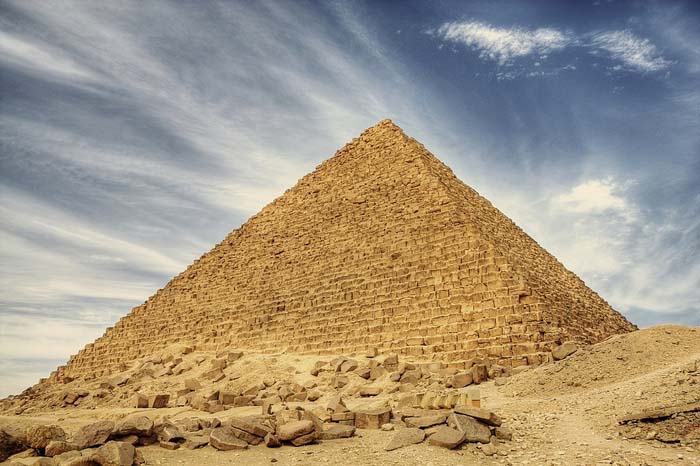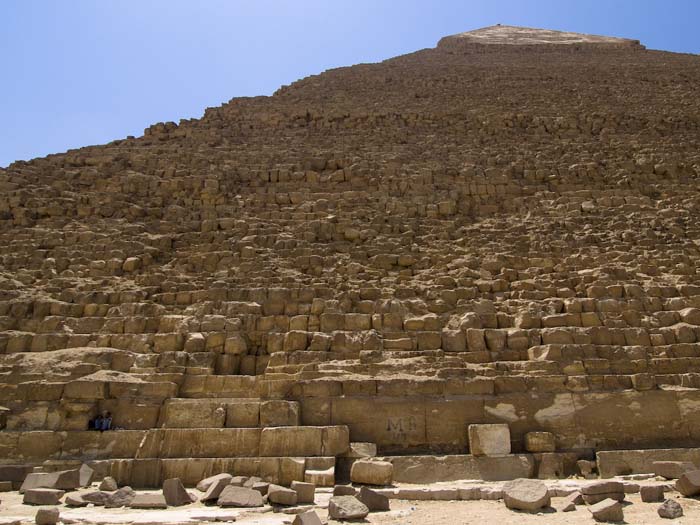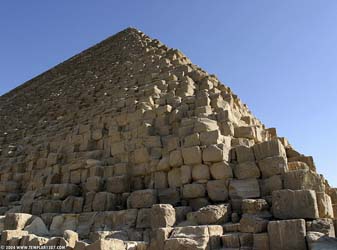Design, Dimensions, and Specifications
Constructed between 2589 and 2504 BC, although estimated dates vary somewhat, the Great Pyramid of Giza is believed to have been designed as a tomb for the Egyptian Pharaoh Khufu, also known as Cheops. Its designer is thought to have been his vizier Hemon; a vizier was the highest official in the land and would have been responsible for ensuring proper construction of the monument. Until the spire of the Lincoln Cathedral was completed, the Great Pyramid was the tallest man-made structure in the world.
 © Never House – The Great Pyramid of Giza
© Never House – The Great Pyramid of Giza
Over time, the size of this monumental structure has diminished somewhat due to the lack of its protective casing stones as well as from environmental factors such as earthquakes. At the time of construction, the Great Pyramid is estimated to have had the following dimensions and specifications:
- Height: 146.5 meters, or 480.6 feet
- Each side: 230.4 meters, or 755.9 feet
- Footprint: 55,000 square meters, or 592,000 square feet
- Weight: 5.9 million tons, estimated
- Blocks: 2.3 million, estimated
- Joint gaps: 0.5 millimeters, or 1/50 inch
- Granite: 7300 mega grams, or 8,000 tons
- Limestone: 4.9 million mega grams, or 5.5 million tons
- Mortar: 454,000 mega grams, or 500,000 tons
Even using current technology, the precision construction of a structure of this size is impossible. The base is level to within 15 millimeters, or .6 inch and the sides of the base are exact to within 58 millimeters of each other. It is aligned to true north with a 3/60 degree error margin.
Estimates for construction time vary from as little as 10 years to as many as 20. Assuming the optimal time of 20 years, the Great Pyramid of Giza would have required placing about 800 tons of blocks each day, which is approximately 12 blocks per hour on a 24/7 basis. The 2.3 million blocks comprising the pyramid weigh from 2 to 30 tons each. An incredibly strong foundation would be required for a structure of such immense size and weight. The underlying ground for the Great Pyramid is a plateau on a mountain of solid granite, therefore it was a perfect site on which to build.
 © Ian Southwell – Base of the Great Pyramid
© Ian Southwell – Base of the Great Pyramid
Since the foundations of the cornerstones have a ball-and-socket construction, the pyramid at Giza can withstand substantial temperature fluctuation as well as acts of nature, such as earthquakes, and still maintain its structural integrity. The Great Pyramid is the only pyramid to have this type of construction.
Although the general consensus has been that the pyramids were built by slave labor, recent discoveries made nearby suggest that the pyramids were actually built by many thousands of skilled workers who were divided into groups according to their skills. Current estimates are that as many as 200,000 skilled laborers were used to construct the pyramid at Giza.
From the air, the Great Pyramid of Giza appears to have eight sides. This is due to a precise and substantial indentation in each side of the pyramid; no other pyramid was built in this manner. The four sides of the Giza pyramid are concave and match the curvature of the earth; again, no other pyramid was constructed in this manner. The overall weight of the Giza pyramid, when multiplied by 10^8 yields the approximate mass of the earth.
The Great Pyramid at Giza is situated at the center of the earth’s land mass. The crossing of the east/west and north/south parallels occur in two places on earth, one of which is at the Great Pyramid.
 © Benjamin – The Great Pyramid
© Benjamin – The Great Pyramid







































